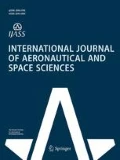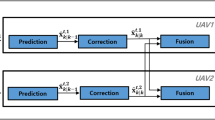Abstract
To address standoff target tracking using a fixed-wing UAV in unknown background wind, a wind estimation based on Unscented Kalman Filter (UKF) is proposed. In the paper, UAV dynamic model and target state estimation are constructed, and Lyapunov vector field guidance (LVFG) framework is introduced to achieve standoff target tracking. The unknown target state and wind dynamic model have seldom been discussed for standoff tracking in the previous research. Therefore, two typical wind dynamic models with Dryden and Davenport spectrums are constructed for the target in the high altitude or near the ground. Then, the unscented transformation is adopted to estimate the position of UAV under guidance command generated by LVFG and saturation constraint. A wind state estimation method based on UKF is proposed to improve performance of standoff tracking. Simulated and realistic ground vehicle trajectories are used to demonstrate the availability and effectiveness of the proposed method for different wind dynamic models.










Similar content being viewed by others
References
Zhang B, Sun X, Liu S, Deng X (2019) Formation control of multiple UAVs incorporating extended state observer-based model predictive approach. Int J Aeronaut Space Sci 20(4):953–963. https://doi.org/10.1007/s42405-019-00180-7
Mahmud I, Cho YZ (2018) Detection avoidance and priority-aware target tracking for UAV group reconnaissance operations. J Intell Robot Syst 92(2):381–392. https://doi.org/10.1007/s10846-017-0745-9
Solazzo D, Sankey JB, Sankey TT, Munson SM (2018) Mapping and measuring aeolian sand dunes with photogrammetry and LiDAR from unmanned aerial vehicles (UAV) and multispectral satellite imagery on the Paria Plateau, AZ, USA. Geomorphology 319:174–185. https://doi.org/10.1016/j.geomorph.2018.07.023
Park S (2016) Circling over a target with relative side bearing. J Guid Control Dyn 39(6):1450–1456. https://doi.org/10.2514/1.G001421
Wise R, Rysdyk R (2006) UAV Coordination for autonomous target tracking. In: AIAA guidance, navigation, and control conference and exhibit, pp 1–22. https://doi.org/10.2514/6.2006-6453
Lawrence DA (2003) Lyapunov Vector Fields for UAV Flock Coordination. In: 2nd AIAA unmanned unlimited systems, technologies, and operations conference, September. https://doi.org/10.2514/6.2003-6575
Nelson DR, Barber DB, McLain TW, Beard RW (2007) Vector field path following for miniature air vehicles. IEEE Trans Robot 23(3):519–529. https://doi.org/10.1109/TRO.2007.898976
Griffiths SR (2006) Vector field approach for curved path following for miniature aerial vehicles. AIAA Guid Navig Control Conf 61:63–64. https://doi.org/10.2514/6.2006-6467
Liang Y, Jia Y, Wang Z, Matsuno F (2015) Vector field guidance for three-dimensional curved path following with fixed-wing UAVs. In: 2015 American Control Conference, Chicago, IL, USA, pp 5980–5985. https://doi.org/10.1109/ACC.2015.7172278
Abozied MAH, Qin S (2017) High performance path following for UAV based on advanced vector field guidance law. In: 2016 IEEE advanced information management, communicates, electronic and automation control conference, IMCEC 2016, pp 555–564, https://doi.org/10.1109/IMCEC.2016.7867272
Chen H (2013) UAV Path Planning with Tangent-plus-Lyapunov Vector Field Guidance and Obstacle Avoidance. IEEE Transactions on Aerospace and Electronic Systems 49(2):840–856, https://ieeexplore.ieee.org/document/6494384
Chen H, Chang K, Agate CS (2009) Tracking with UAV using Tangent-plus-Lyapunov Vector Field Guidance. In: 12th International Conference on Information Fusion, pp 363–372
Frew EW, Lawrence DA, Morris S (2008) Coordinated standoff tracking of moving targets using lyapunov guidance vector fields. J Guid Contro Dyn 31(2):290–306. https://doi.org/10.2514/1.30507
Pothen AA, Ratnoo A (2017) Curvature–constrained lyapunov vector field for standoff target tracking. J Guid Control Dyn 40(10):2729–2736. https://doi.org/10.2514/1.G002281
Thomasson PG (2008) Guidance of a roll-only camera for ground observation in wind. J Guid Control Dyn 21(1):39–44. https://doi.org/10.2514/2.4230
Osborne J, Rysdyk R (2005) Waypoint Guidance for Small UAVs in Wind. In: AAIA, pp 1–12. https://doi.org/10.2514/6.2005-6951
Rysdyk R (2006) Unmanned aerial vehicle path following for target observation in wind. J Guid Control Dyn 29(5):1092–1100. https://doi.org/10.2514/1.19101
Zhu S, Wang D, Low CB (2013) Ground target tracking using UAV with input constraints. J Intell Robot Syst Theory Appl 69(1–4):417–429. https://doi.org/10.1007/s10846-012-9737-y
Summers TH, Akella MR, Mears MJ (2009) Coordinated standoff tracking of moving targets: control laws and information architectures. J Guid Control Dyn 32(1):56–69. https://doi.org/10.2514/1.37212. arXiv: 0901.2772
Kim S, Oh H, Tsourdos A (2013) Nonlinear model predictive coordinated standoff tracking of a moving ground vehicle. J Guid Control Dyn 36(2):557–566. https://doi.org/10.2514/1.56254
Oh H, Kim S, Tsourdos A, White BA (2014) Decentralised Standoff tracking of moving targets using adaptive sliding mode control for UAVs. J Intell Robot Syst Theory Appl 76(1):169–183. https://doi.org/10.1007/s10846-013-9864-0
Ren W (2007) Trajectory tracking control for a miniature fixed-wing unmanned air vehicle. Int J Syst Sci 38:361–368. https://doi.org/10.1080/00207720601170586
Vikranth S, Sudheesh P, Jayakumar M (2016) Nonlinear tracking of target submarine using extended Kalman filter (EKF). Commun Comput Inform Sci 625:258–268
He Y, Xiu JJ, Guan X, Zhang JW (2013) Radar data processing with applications, 3rd edn. Publishing House of Electronics Industry, Beijing
Julier SJ, Uhlmann JK (2004) Unscented filtering and nonlinear estimation. Proc IEEE 92(3):401–422. https://doi.org/10.1109/JPROC.2003.823141
Arasaratnam I, Haykin S (2009) Cubature kalman filters. IEEE Trans Autom Control 54(6):1254–1269. https://doi.org/10.1109/TAC.2009.2019800
Lim S, Kim Y, Lee D, Bang H (2013) Standoff target tracking using a vector field for multiple unmanned aircrafts. J Intell Robot Syst Theory Appl 69(1–4):347–360. https://doi.org/10.1007/s10846-012-9765-7
Tr BEAL (2008) Digital simulation of atmospheric turbulence for Dryden and von Karman models. J Guid Control Dyn 16(1):132–138. https://doi.org/10.2514/3.11437
Gawronski W (2004) Modeling wind–gust disturbances for the analysis of antenna pointing accuracy. IEEE Anten Propagat Mag 46(1):50–58. https://doi.org/10.1109/MAP.2004.1296144
Zheng Y, Li Q, Chen Y, Xie X, Ma WY (2008) Understanding mobility based on GPS data. In: Proceedings of ACM conference on ubiquitous computing (UbiComp 2008), ACM Press, Seoul, Korea, pp 312–321. https://doi.org/10.1145/1409635.1409677
Zheng Y, Zhang L, Xie X, Ma WY (2009) Mining interesting locations and travel sequences from GPS trajectories. In: Proceedings of International World Wide Web Conference on World Wild Web (WWW 2009), ACM Press, Madrid Spain, pp 791–800. https://doi.org/10.1145/1526709.1526816
Mehrotra K, Mahapatra PR (1997) A jerk model for tracking highly maneuvering targets. IEEE Trans Aerosp Electron Syst 33(4):1094–1105. https://doi.org/10.1109/7.sps624345
Acknowledgements
This work is supported in part by the National Natural Science Foundation of China (Nos. 91538201, 61531020, and 61671463).
Author information
Authors and Affiliations
Corresponding author
Additional information
Publisher's Note
Springer Nature remains neutral with regard to jurisdictional claims in published maps and institutional affiliations.
Rights and permissions
About this article
Cite this article
Sun, S., Dong, K., Guo, C. et al. A Wind Estimation Based on Unscented Kalman Filter for Standoff Target Tracking Using a Fixed-Wing UAV. Int. J. Aeronaut. Space Sci. 22, 366–375 (2021). https://doi.org/10.1007/s42405-020-00290-7
Received:
Revised:
Accepted:
Published:
Issue Date:
DOI: https://doi.org/10.1007/s42405-020-00290-7




